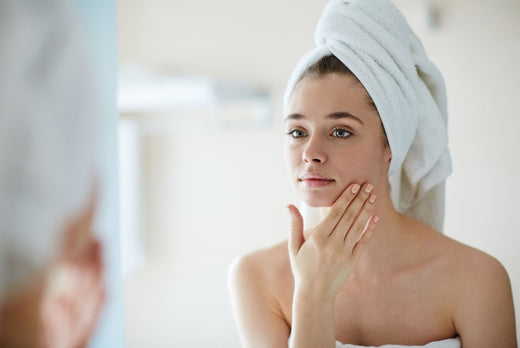

Red, flushed skin can be attributed to a number of things, whether it's warm weather, an intense workout, or simply feeling excited or embarrassed. Sometimes redness can occur because of a skin condition, such as rosacea, or issues like endocrine disorders that we can't easily see.
While some causes of redness are a bit easier to treat than others, and perhaps only require a pat-down with cool water or a calming mask, others require intensive treatments with the help of a skin care pro.
Whatever the case, finding a way to calm red, flushed skin can be done once you identify the cause. To find out more, specifically, why some skin types commonly experience symptoms like redness and flushing, we offer 10 ways on what you can do to calm your skin when this happens, and which signs may indicate an issue that may require professional assistance.
-
Wear a Soothing Mask
If you don’t need to constrict your blood vessels but seek to calm red skin that’s caused by dryness or inflammation, natural face masks and sheet masks make for great at-home treatments when they contain the right ingredients. Rosewater is known for reducing redness and calming irritated skin. Plus, it's naturally packed with vitamins A, C, and E, which will leave your skin looking and smelling fantastic in mere minutes.
If you're feeling crafty, try out a DIY face mask. They're easy to make and also include common ingredients and household items. Look into avocado-based or oatmeal face mask recipes as well to help calm flushed skin.
-
Apply a Cool Compress
If your red or flushed skin isn’t due to an underlying medical condition, treating it can be done by applying a cool compress to the affected area. In most cases, the skin becomes flushed as a result of the blood vessels widening in that area, which then allows for more blood to flow through.
This is why some people experience redness during exercise, when they drink alcohol, or if they become embarrassed—which we'll get to in a minute. To calm flushed skin, place a clean washcloth in a plastic bag filled with ice cubes and leave it in the freezer for about 15 minutes. Then, remove the cloth and gently apply it to the skin for about 20 minutes.
-
Color-Correct With Visine
For years, Visine has promised to “get the red out” of our eyes, and as it turns out, that same color-correcting magic can work on skin. Like ice or cold water, Visine constricts blood vessels to reduce redness by restricting blood flow to the area. Many people already know that a few drops of Visine on an inflamed pimple can offer temporary relief from redness, and you could try implementing this practice to any affected areas of the skin by combining a little Visine mixed with moisturizer.
-
Look Into Swapping for Natural Skin Care Ingredients
Organic ingredients like coconut oil, shea butter, aloe vera, and manuka honey are known for working wonders of red skin. Whether it’s Rosacea or just sensitive skin, these natural options can be incorporated into your skin care routine via serums or face creams, or DIY masks!
-
Avoid Irritating Products
Redness can be exacerbated by certain ingredients in our skin care—namely acids, which are commonly used to exfoliate the skin. Steer clear of strong retinoids or retinol, as these products can further irritate sensitive skin, as well as harsh physical exfoliants and polishing scrubs. Some acne products can be drying and should be used with caution if you have sensitive skin, such as benzoyl peroxide, salicylic acid, and glycolic acids.
Benzoyl peroxide is an organic acid in the peroxide family that has been used to treat acne because of its keratolytic, moderate comedolytic, and antibacterial properties, which include the reduction of P. acnes and Staph. aureus on the skin.
If you can’t part ways with your favorite acid-enhanced product, limit your use to just a few times a week or look to formulas that contain a low percentage of the good stuff. For example, many products containing glycolic acid may fall between 10 to 20 percent glycolic acid, although some only have 7% or 2%, which may be ideal for skin that becomes red or irritated easily.
Even if you're not using harsh acids, it's a good idea to use a gentle cleanser twice daily. Also, apply a moisturizer with SPF 30 or higher every morning, and use a nourishing moisturizer at night. Try using a low-dose retinol as well.
-
Revise Your Diet
Underlying redness can simply be related to a few outside factors. This is, of course, if you're not dealing with a certified medical condition. If your redness is less medical and more environmental, sometimes it can be broken down into making simple changes in things like your diet.
An anti-inflammatory diet, which includes green leafy vegetables, fish, essential oils, and low-glycemic fruits is great to try. Even more importantly it excludes simple sugars, grains, non-organic meats and dairy, and high-glycemic fruits. Pre- and probiotics are a must. Vitamin D supplements also help, even in people with normal vitamin D levels.
Vitamin D is a fat-soluble vitamin and one of the most critical vitamins for biological function. Our skin is an important natural reservoir for its production, triggered by UV light into synthesis. The vitamin helps protect the skin, decreases inflammation, and normalizes cell production.
In the same way that certain skincare ingredients may trigger the outer layer of the skin, some foods and drinks can inflame and irritate skin from the inside.
These foods tend to have high acidic content and can regularly produce flushed cheeks and persisting redness. If you’re prone to redness or rosacea, then you can avoid triggers, such as spicy foods, citrus, tomato, chocolate, and cinnamon. Additionally, heat, extremes in temperatures (either hot or cold), wind exposure, alcohol, and some warm beverages as additional triggers that can lead to redness or may induce rosacea symptoms.
-
Make Lifestyle Changes
While persisting redness can be a frustrating problem, and when it comes to rosacea, an actual skin condition, the cause is often more than skin deep. This can mean that the solution can require more than one step and can involve the medication, treatments, and dietary changes that we spoke about above. As for the lifestyle modifications you can make the following:
- Decrease sun/UV exposure
- Stop smoking
- Stop drinking hot beverages
- Drink cold water while exercising
While this won't necessarily "cure" redness, doing things like avoiding excessive sun exposure or using a cool compress can help reduce symptoms temporarily.
-
Try a Multifactorial Approach
Sometimes skin redness or flushing requires treatments and ingredients that at-home DIY solutions can’t offer. Calming red skin depends on its cause, especially when dealing with a skin condition. Rosacea is the most common cause of facial redness they see at his practice. The best approach to treating this is multifactorial—or functional. It includes a combination of nutrition and lifestyle modification, skincare, medications, and procedures, such as laser.
Procedures such as micro needling with platelet-rich plasma (PRP), which are anti-inflammatory, can often help those that have an acne/rosacea combination. Micro needling works by resurfacing the skin and decreasing inflammation.
-
Talk to Your Doctor
If your other options have been exhausted and you still can’t find relief from redness or flushing, it is always a good idea to consult your physician, especially if redness is combined with additional symptoms.
If the red, flushed skin is associated with a rapid heart rate, sweating, and/or diarrhea, that is something more concerning that warrants further workup. Carcinoid tumors or pheochromocytomas are tumors that can cause flushing and a racing heart, for example. Most cases of flushing, however, are just a benign genetic tendency.
-
Read the Labels on Your Products
We cannot stress this enough, but most skin care products contain harsh chemicals, preservatives, and fragrances that cause irritation. For those with Rosacea, this means that the products you’re putting on your face are actually making your skin condition worse. So, read that ingredient list and consider throwing it out if you see any of these:
- Sulfates
- Mineral Oil
- Petroleum
- Parfum
- Parabens
- Paraffin
If you need to look for a new brand to use, check out Wild Naturals! Our products are natural and organic, with only Earth-made ingredients that will soothe, nourish, and repair your skin for healthy, glowing skin! Shop the Wild Naturals online store today and help relieve your red, flushed skin now!


